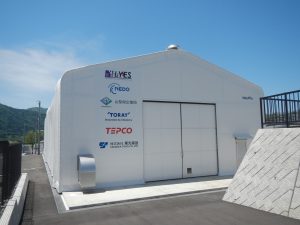
P2G Demonstration Research Building
Yamanashi Prefecture(*1) is actively exploring introducing green hydrogen production and uses as it works towards carbon neutrality.
In collaboration with several private companies, Yamanashi Prefecture has developed a P2G (Power to Gas) system to produce hydrogen and advance the technical developments around its use.
The technology of P2G systems uses electricity produced by renewable energy, such as solar energy, to power water electrolysis which produces green hydrogen.
In order to develop further the results of P2G systems and implement their goal of becoming carbon neutral, in February 2022 Yamanashi prefecture collaborated with the Tokyo Electric Power Company (TEPCO) and Toray Industries to establish Japan’s first P2G company, the Yamanashi Hydrogen Company (YHC).
Recently the start of the ‘Empirical Research for the Introduction of P2G Systems to Decarbonize Urban Areas in Cold Regions Energy Use in Renewable Energy Expansion Areas’ was announced in Glasgow, in collaboration with YHC, TEPCO, the Marubeni Corporation and Siemens Energy.
The national alternative energy research and development agency New Energy and Industrial Technology Development Organization (NEDO) was influenced by a second public appeal by these four companies to adopt the ‘International Demonstration Project for Japanese Technologies Contributing to Energy Consumption Efficiency, etc. (Survey on Conformance with Demonstration Requirements, etc.)’ The proposal was adopted on the 27th of October 2022.
Using Scotland’s huge reserves of renewable energy, Toray and Siemens Energy’s technical prowess and YHC’s P2G system, they will investigate the requirements and compatibility of green hydrogen production.
In addition, studies are being carried out into production methods, urban areas in cold regions heating need to make green hydrogen a new energy supply and how to use green hydrogen in heating systems for large facilities and industrial boilers.
Through this study, by contributing to Scotland’s decarbonisation and examining how to adopt this expertise into the European market where renewable energy is increasingly used, Japan and the UK can welcome a green hydrogen manufacturing value chain and work towards the goal of becoming a hydrogen-based society.
(*1)
Roughly in the middle of the Japanese archipelago, Yamanashi is a landlocked prefecture to the west of Tokyo Metropolitan. It is surrounded by beautiful mountains and rich nature, such as the World Heritage Mt. Fuji.
As well as having the highest production output of grapes, peaches and Japanese plums in Japan, Yamanashi is also famous for its water and has the highest number of mineral water shipments in Japan. Yamanashi also boasts the highest wine production and a number of wineries in Japan. ‘Yamanashi’ was the first geographical indication registered for Japanese wine. Wines from Yamanashi such as Koshu Wine are valued the world over.
In addition, thanks to a number of world-class hydrogen and fuel cell research sites, Yamanashi is also known as an area specialising in the advancement of hydrogen and fuel cells.
Reference:
・https://www.toray.com/global/news/details/20221201105606.html
・https://www.marubeni.com/en/news/2022/info/00022.html
・https://www.pref.yamanashi.jp/newene-sys/documents/r041125_yhc.pdf

